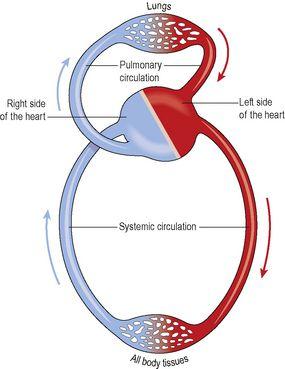Ross & Wilson Anatomy and Physiology in Health and Illness (35 page)
Read Ross & Wilson Anatomy and Physiology in Health and Illness Online
Authors: Anne Waugh,Allison Grant
Tags: #Medical, #Nursing, #General, #Anatomy

The two main forms of haemophilia differ only in the clotting factor involved; the clinical picture in both is identical.
•
Haemophilia A. In this disease, factor VIII is abnormal and is less biologically active.
•
Haemophilia B (Christmas disease). This is less common and factor IX is deficient, resulting in deficiency of thromboplastin (clotting factor III).
von Willebrand’s disease
In this disease, a deficiency in the von Willebrand factor causes low levels of factor VIII. As the inheritance is not sex linked, haemorrhages due to impaired clotting occur equally in males and females.
For a range of self-assessment exercises on thetopics in this chapter, visit
www.rossandwilson.com
.
CHAPTER 5
The cardiovascular system
Blood vessels
74
Control of blood vessel diameter
76
Capillary exchange
77
Heart
78
Position
78
Structure
79
Flow of blood through the heart
81
Blood supply to the heart (the coronary circulation)
82
Conducting system of the heart
83
The cardiac cycle
84
Cardiac output
85
Blood pressure
87
Factors determining blood pressure
87
Control of blood pressure (BP)
88
Pulse
90
Circulation of the blood
91
Pulmonary circulation
91
Systemic or general circulation
94
Aorta
94
Summary of the main blood vessels
106
Fetal circulation
108
Features of the fetal circulation
108
Changes at birth
110
Shock
111
Thrombosis and embolism
112
Blood vessel pathology
113
Atheroma
113
Arteriosclerosis
115
Aneurysms
115
Venous thrombosis
116
Varicose veins
116
Tumours of blood and lymph vessels
117
Oedema
117
Ascites and effusions
118
Diseases of the heart
119
Heart (cardiac) failure
119
Disorders of heart valves
120
Ischaemic heart disease
120
Rheumatic heart disease
121
Infective endocarditis
121
Cardiac arrhythmias
122
Congenital abnormalities
123
Disorders of blood pressure
124
Hypertension
124
Hypotension
126
ANIMATIONS
5.1
Blood vessels
74
5.2
Location of the heart
78
5.3
Chambers of the heart
80
5.4
Heart valves and sounds
81
5.5
Left ventricular valves
82
5.6
Coronary circulation
82
5.7
Conduction of heart impulses
83
5.8
Events represented by the ECG
85
5.9
Pulse points
90
5.10
Pulmonary circulation
91
5.11
Hepatic portal circulation
102
5.12
Fetal circulation
108
5.13
The effects of atheroma on blood flow
114
5.14
Disorders of the heart valves
120
The cardiovascular (cardio – heart, vascular – blood vessels) system is divided for descriptive purposes into two main parts:
•
the
heart
, whose pumping action ensures constant circulation of the blood
•
the
blood vessels,
which form a lengthy network through which the blood flows.
The
lymphatic system
is closely connected, both structurally and functionally, with the cardiovascular system and is discussed in
Chapter 6
.
The heart pumps blood into two anatomically separate systems of blood vessels (
Fig. 5.1
):
•
the pulmonary circulation
•
the systemic circulation.
Figure 5.1
The relationship between the pulmonary and the systemic circulations.
The right side of the heart pumps blood to the lungs (the pulmonary circulation) where gas exchange occurs, i.e. the blood collects oxygen from the airsacs and excess carbon dioxide diffuses into the airsacs for exhalation. The left side of the heart pumps blood into the systemic circulation, which supplies the rest of the body. Here, tissue wastes are passed into the blood for excretion, and body cells extract nutrients and O
2
.
The circulatory system ensures a continuous flow of blood to all body cells, and its function is subject to continual physiological adjustments to maintain an adequate blood supply. Should the supply of oxygen and nutrients to body cells become inadequate, tissue damage occurs and cell death may follow.
Disease of the cardiovascular system is likely to have significant consequences, not only for the heart and blood vessels, but also for other body systems, which is discussed from
page 111
.
Blood vessels
Learning outcomes
After studying this section, you should be able to:
describe the structures and functions of arteries, veins and capillaries


